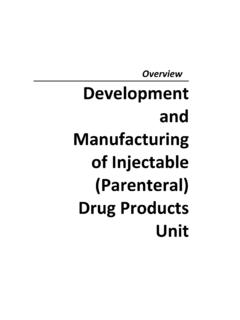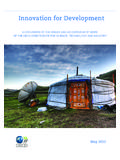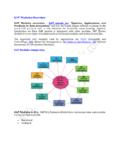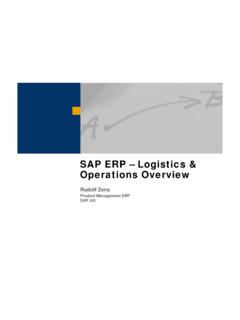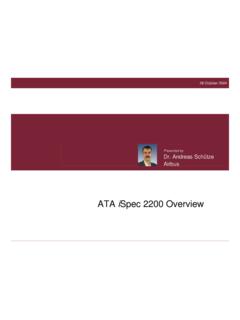Transcription of Economic Growth and Real Exchange Rate: An …
1 This PDF is a selection from an out-of-print volume from the National Bureau of Economic Research Volume Title: Changes in Exchange rates in Rapidly development Countries: Theory, Practice, and Policy Issues (NBER-EASE volume 7). Volume Author/Editor: Takatoshi Ito and Anne O. Krueger, editors Volume Publisher: University of Chicago Press Volume ISBN: 0-226-38673-2. Volume URL: Publication Date: January 1999. Chapter Title: Economic Growth and real Exchange Rate: An Overview of the Balassa-Samuelson Hypothesis in Asia Chapter Author: Takatoshi Ito, Peter Isard, Steven Symansky Chapter URL: Chapter pages in book: (p. 109 - 132). 4 Economic Growth and real Exchange Rate: An Overview of the Balassa-Samuelson Hypothesis in Asia Takatoshi Ito, Peter Isard, and Steven Symansky Introduction The relationship between the Exchange rate and Economic development is certainly an important subject, from both a positive (descriptive)and a norma- tive (policy prescription) perspective.
2 Several developing countries that have implicitly or explicitly fixed their Exchange rates to the currency of another country (say, the dollar) and whose inflation rates are higher than that of the foreign country (the United States) often experience persistent current ac- count deficits and eventual devaluations of their currencies. Devaluation often invites a recession and inflation and thus pushes the economy into an inflation- devaluation spiral, causing a serious setback in Economic development . Other developing countries grow exceptionally fast and often face the opposite pres- sure on their high Economic Growth rate is most likely accompa- nied by a high investment rate, and high export Growth as well. Successful exports produce current account surpluses, resulting in nominal appreciation pressure on the currency unless the central bank intervenes in the foreign ex- change market and accumulates foreign reserves.
3 Even if the intervention maintains the fixed Exchange rate, unsterilized intervention results in inflation, and the real Exchange rate appreciates anyway. In the world of free capital mobility, another channel for appreciation exists. Fast Growth often invites in- Takatoshi Ito is professor in the Institute of Economic Research at Hitotsubashi University, Tokyo, and a research associate of the National Bureau of Economic Research. Peter Isard is division chief in the research department of the International Monetary Fund. Steven Symansky is deputy division chief in the fiscal affairs department of the International Monetary Fund. Comments from Anne Krueger, Kenichi Ohno, and other conference participants were very helpful in revising the paper. Help in obtaining data by Kenneth Lin and Baekin Cha is appreci- ated. This paper was written when the first author was senior advisor in the research department of the International Monetary Fund.
4 Research assistance by Susanna Mursula is also appreciated. The views and opinions expressed in this paper do not necessarily represent those of the Interna- tional Monetary Fund or the National Bureau of Economic Research. 109. 110 Takatoshi Ito, Peter Isard, and Steven Symansky flows of foreign capital. Some investors in industrial countries pursue high returns (even with high risk) as part of a diversified portfolio. Capital inflows put pressure on the (nominal) Exchange rate to appreciate. For example, de- mand for the currency of an emerging market will rise when foreign investors plan to purchase bonds and stocks, because the local currency has to be ob- tained first. Put simply, successful Economic development results in a currency appreciation with improvement in the standard of living, while failure in eco- nomic development often results in a sharp currency depreciation.
5 One of the most popular hypotheses with respect to long-term real Exchange rate movements is the so-called Balassa-Samuelson hypothesis, which conjec- tures that productivity increases in the tradable sector tend to be higher than those in the nontradable sector, so that the conventionally constructed real ex- change rate (using a price index that includes both tradable and nontradable prices, such as the CPI or GDP deflator) will move in a manner that reflects cross-country differences in the relative speed of productivity increases be- tween the tradable and nontradable sectors.' Since the differences in productiv- ity increases are expected to be larger in high- Growth countries, the Balassa- Samuelson prediction should be most visible among rapidly growing coun- tries. It is well known in the literature that the postwar Japanese record has been a prime example of the Balassa-Samuelson hypothesis.
6 However, one country does not prove the case. Hence, the Asian emerging markets with high Growth rates seem to offer a good testing ground. A few additional thoughts and regressions are also shown and interpreted. Although the Balassa-Samuelson hypothesis makes a prediction about the movement of the real Exchange rate based on the common pattern (tradable sector productivity Growth is higher than nontradable) among high- Growth countries, the original mechanism for high Growth is not explained. The pres- ent paper examines why some countries grow faster and whether the mecha- nism for high Growth makes a difference in proving or refuting the Balassa- Samuelson hypothesis. Japan and other high- Growth countries in East Asia have completed, or have been experiencing, a transformation from agricultural, stagnant economies to manufacturing, export-oriented, growing economies.
7 Their success is based on a change in industrial structure, gradually moving up a technological ladder. In many countries, Economic development changed the structure from low- value-added goods sectors, such as primary goods and textiles, to high-value- added goods sectors, such as manufacturing and machinery. Moreover, each sector changes its trade status from net importer, to domestically self- sufficient, to net exporter. The important element of Economic development in Asia seems to be a constant upgrading (higher quality and more sophisticated 1. The original articles are Balassa (1964) and Samuelson (1964). For recent studies, see Asea and Mendoza (1994), De Gregorio and Wolf (1994). De Gregorio, Giovannini, and Wolf (1994), Marston (1990). See also Corden (1960). This paper draws heavily on Ito et al. (1996) but has a different emphasis and updated data.)
8 111 Economic Growth and real Exchange Rate products) of the industrial structure and exporting goods. This observation is sometimes nicknamed the flying geese pattern of Economic Its original meaning was that a particular manufacturing sector, such as the steel industry in Japan, experiences stages from an import surge, to a domestic production surge replacing imports, to an export surge; then the same pattern is repeated in the next industry up the sophistication ladder, say the automobile industry. The more recent, popularized version of the flying geese pattern is that the different Asian countries experience the same pattern of industrial de- velopment but with time lags. At a particular point in time, Japan is a leader followed by Singapore and Hong Kong, which are followed by Korea and Tai- wan, and then by Thailand and Indonesia, and so forth.
9 We will make observa- tions about the relationship between the Balassa-Samuelson hypothesis and the flying geese hypothesis below. The rest of the paper is organized as follows. In section , the relationship between changes in real Exchange rates and Growth rates among East Asian countries is reviewed. Section examines the relationship between machin- ery exports and Growth . Section examines a relationship between export characteristics and Growth , and another between export characteristics and real Exchange rate changes. Section examines the link between the Balassa- Samuelson hypothesis and stages of Economic development . The link between productivity Growth and relative price changes, one of the important links in the Balassa-Samuelson hypothesis, is examined in section using sectoral data for Japan and the United States during 1960-92.
10 Stylized Facts about the Balassa-Samuelson in APEC. For testing the Balassa-Samuelson hypothesis, the relationship between the Growth rate and changes in the real Exchange rate is examined. The Asia- Pacific Economic Cooperation Council (APEC) countries and economies are taken as examples here. Since Economic development stages differ widely among APEC countries, the examination will be a good test of how universally the Balassa-Samuelson hypothesis may apply. The Growth rate and real Exchange rate change are defined as follows. The Growth rate, denoted by dG(j, t + k), is the average per capita GDP Growth rate of country j between t and t + k Y ( j ,t + k ) = [I + dG(j, t + k)lkY(j,t ) , where Y(j,t) is per capita GDP of country j in year t. The Growth rate relative to the United States is the difference between dG(j)and dG(US).]










